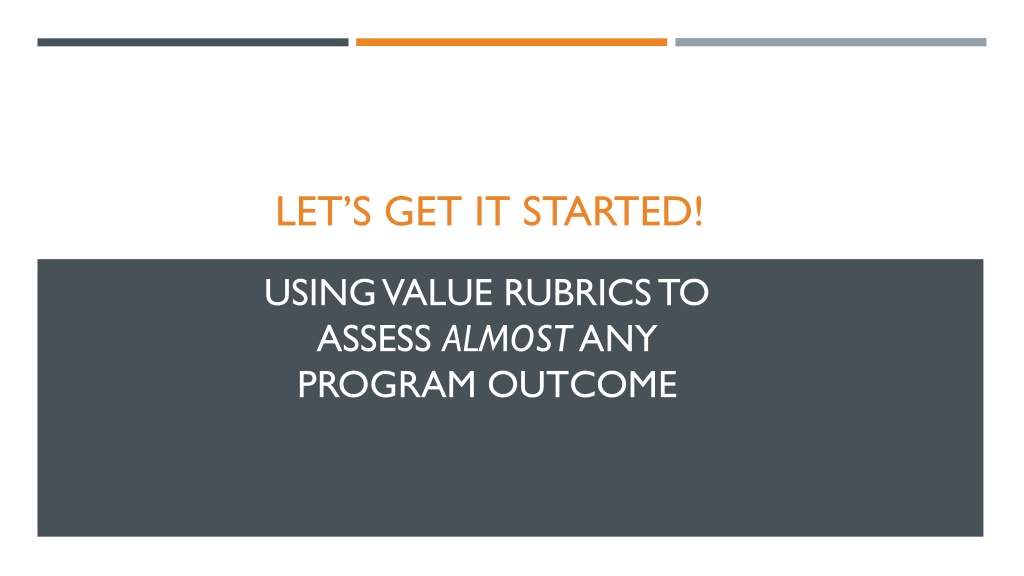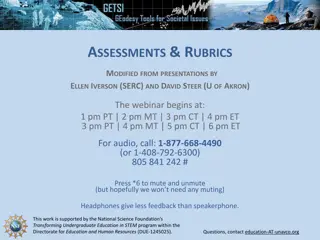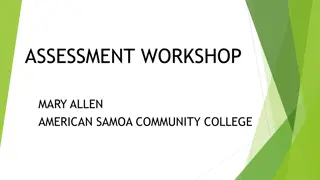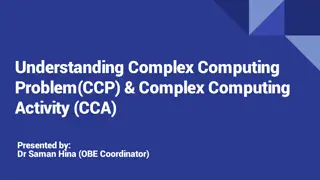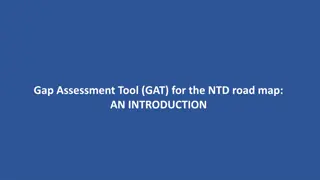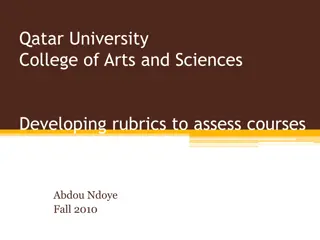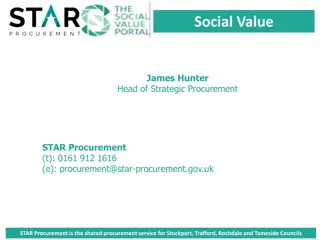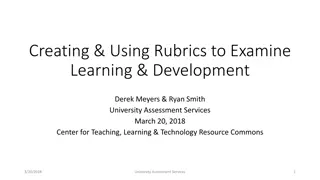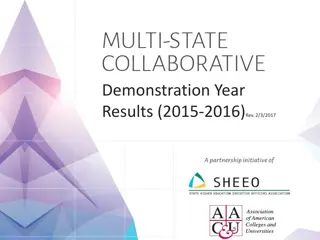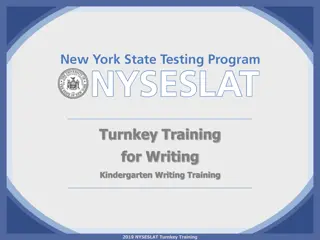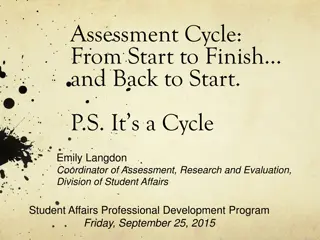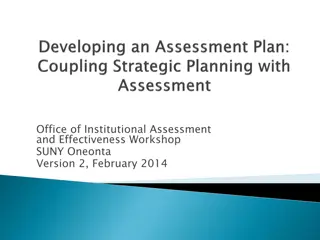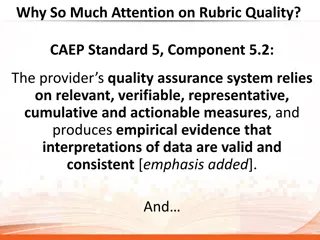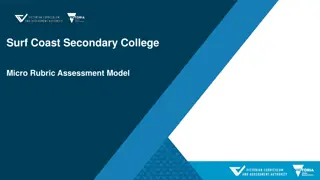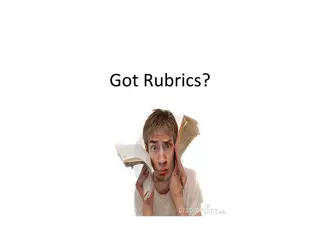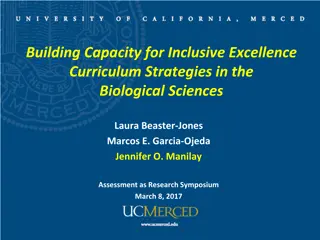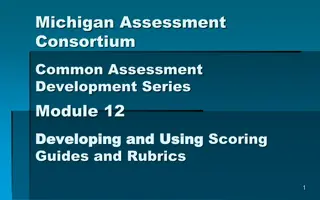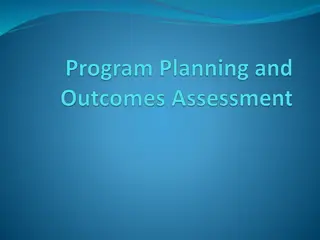Value Rubrics for Comprehensive Program Assessment
Explore the use of VALUE rubrics for assessing program outcomes, creating aligned assignments, collecting student work effectively, and improving student skills. Learn about AAC&U's 15 VALUE rubrics and their applications in course and program evaluation. Discover how to define performance levels and enhance student learning through authentic assessment practices.
Download Presentation

Please find below an Image/Link to download the presentation.
The content on the website is provided AS IS for your information and personal use only. It may not be sold, licensed, or shared on other websites without obtaining consent from the author.If you encounter any issues during the download, it is possible that the publisher has removed the file from their server.
You are allowed to download the files provided on this website for personal or commercial use, subject to the condition that they are used lawfully. All files are the property of their respective owners.
The content on the website is provided AS IS for your information and personal use only. It may not be sold, licensed, or shared on other websites without obtaining consent from the author.
E N D
Presentation Transcript
LETS GET IT STARTED! USING VALUE RUBRICS TO ASSESS ALMOSTANY PROGRAM OUTCOME
WORKSHOP OUTCOMES As a result of this workshop you will be able to: Describe how VALUE rubrics can be used for program assessment Create a signature or key assignment that is aligned with program learning outcomes Collect student work from multiple course sections and/or instructors Use results to help students improve their skills and content knowledge
THE ASSESSMENT CYCLE Today!
WHAT ARE VALUE RUBRICS? AAC&U (Association of American Colleges and Universities) s VALUE (Valid Assessment of Learning in Undergraduate Education) project A component of the LEAP (Liberal Education and America s Promise) initiative Goals: Develop shared understanding of student learning outcomes Promote authentic assessment of student work (vs. standardized tests) Teams of faculty and academic affairs professionals synthesized rubrics into 15 areas of learning.
AAC&US 15 VALUE RUBRICS Intellectual and Practical Skills: Inquiry and analysis Critical thinking Creative thinking Written communication Oral communication Quantitative literacy Information literacy Teamwork Problem solving Personal and Social Responsibility: Civic knowledge and engagement local and global Intercultural knowledge and competence Ethical reasoning and action Foundations and skills for lifelong learning Integrative and applied learning
POSSIBLE USES OF VALUE RUBRICS Course evaluation Models for rubrics faculty can use to score of class assignments Student reflection Program evaluation Help specify department learning outcomes Models for rubrics for program-level evaluation projects
LEVEL OF PERFORMANCE DESCRIPTORS Capstone- culminating level of achievement expected for baccalaureate degree Milestones- progressively more sophisticated performance Not intended for 1 = freshmen, 2 = sophomore, or 4 = A, 3 = B, etc.
MODIFYING VALUE RUBRICS Meant to be modified! Add more specific criteria based on your program or assignment Add new dimensions to reflect issues important to your program
SALT LAKE COMMUNITY COLLEGE Require instructors to use of signature assignments to assess their general education outcomes, but allow faculty freedom in creating the assignments. A few general requirements for the assignments: address at least two learning outcomes include student reflection demonstrate a real world, not theoretical, application of disciplinary knowledge A mathematics instructor created a signature assignment where students acted as potential car buyers and calculated how different interest rates affect the amount of money spent. Learning outcomes- quantitative literacy and written communication Students reflect on how this activity can be applied in other classes or real world scenarios.
ORAL COMMUNICATION SCORES: PSYCHOLOGY (N = 23) Proficiency Score Organization Language Delivery Supporting Material Central Message 3.75-4.0 0 (0%) 3 (13%) 1 (4%) 2 (9%) 1 (4%) 3.0-3.5 15 (65%) 14 (61%) 10 (44%) 15 (65%) 18 (78%) 2.0-2.75 8 (35%) 6 (26%) 9 (39%) 6 (26%) 4 (17%) 1.0-1.75 0 (0%) 0 (0%) 3 (13%) 0 (0%) 0 (0%) Note. Scoring was as follows: 1 = Benchmark (Does not Meet Competency), 2 = Milestone (Minimal Competency), 3 = Milestone (Meets Competency), 4 = Capstone (Exceeds Competency). What trends do you notice? What questions are left unanswered? How could we collect more useful data?
ACTIVITY #1: CHOOSING AN OUTCOME How do these align with your Program Learning Outcomes? Which learning outcomes are emphasized by your program? What are your strengths and weaknesses? Which seems like a priority for assessment?
WHERE IS THE OUTCOME TAUGHT IN YOUR CURRICULUM? 1500 2000 3020 3040 3080 3100 3220 3230 4110 4120 4250 4650 PLO1 I D D D D D M M PLO2 I D D M PLO3 I D D PLO4 I D D D D D D D M M PLO5 I D D M PLO6 I D PLO7 I D D M I = Introduced; D = Developed/Reinforced; M = Mastered
WHAT IS A SIGNATURE ASSIGNMENT? Embedded in a course Used for course grade and program assessment Aligned with Program Learning Outcomes Collaboratively designed by faculty Meaningful and integrative Why? Allows a program to assess learning across course sections or instructors Creates consistency Useful for assessing course sections with different modalities/pedagogies
Assignment 3 (to be assessed with the VALUE rubrics Written Communication and Intercultural Understanding) Instructions: Please take approximately 1 2 hours to complete this assignment. The essay topic is designed to give you an opportunity to demonstrate your ability to write clearly and effectively. It will also allow you to display your knowledge of psychological diversity. Perfection is not expected, but you should try to produce the best essay possible in the time allotted. Your essay should be about 2 pages in length (4-5 paragraphs). Type this assignment and then upload the digital file to the course Moodle site. You do not have to cite sources in this essay, but please include specific terms and concepts from your psychology classes. Prompt: Think about a group of people who are very different from you. These could be individuals from a different culture or perhaps members of a social group that hold views you disagree with. Briefly describe the group s characteristics and how individuals in this group are different from you. Then, describe 1-3 concepts that you ve learned from this class (or other psychology classes you ve taken) that could be used to change or improve the way you interact with members of this group
ACTIVITY #2: SIGNATURE ASSIGNMENT What courses would use this assignment? Describe instructions to students, providing explicit guidelines on: Learning outcomes and goals How to complete the assignment Length and time required Sources needed Evaluation criteria
GATHER AND EVALUATE Student Assignments Student Assignments Student Assignments Student Assignments Student Assignments Student Assignments Student Assignments Student Assignments Student Assignments Student Assignments Student Assignments Student Assignments Student Assignments Student Assignments Student Assignments Grade to students Grade to students Grade to students Course #3 Instructor Course #2 Instructor Course #1 Instructor Course Instructor(s) Score Assignments Team of Faculty Score Assignments or Assessment Coordinator or Committee Compile Results Program Faculty Reflect on Results
SCORING ASSIGNMENTS: RUBRIC CALIBRATION Hold a calibration session with all instructors or faculty scorers. Begin with a close reading of the rubric and identify areas of discussion. Faculty should come to an agreement on interpretation of language in rubric. Faculty are given an example of student work to score. Discuss scores row by row. Faculty provide rationale for their scores and try to reach consensus. Goal is to identify two scores around with the majority cluster. Repeat with more examples of student work (high, low, medium)
ACTIVITY #3: ASSESSMENT PLAN What assignment or activity will you use? How will you score student achievement? What classes would you target for sampling and when? Which faculty will be responsible for coordinating data collection? Data analysis? How will you analyze the results? Will you disaggregate results in some way? How will results be shared, discussed, and used to make changes? When will the PLO be assessed again?
DOS AND DONTS OF DATA COLLECTION AND ANALYSIS DO DON T Wait until the last minute Form a department assessment committee charged with regularly collecting and disseminating data Pressure faculty to comply with assessment activities Ask for faculty volunteers Give faculty early notice regarding assessment plans Use assessment results to call attention to, judge, or punish individual faculty or students Disaggregate results across time, populations, and outcomes Expect perfection Protect the confidentiality and anonymity of students and faculty by examining results at the group level Collect more data than you can use Use results to inform changes
USING RESULTS TO CREATE A CULTURE OF EVIDENCE Use results: To examine skill development across the curriculum To examine curriculum content coverage and areas for program modification To improve instruction and introduce new pedagogies Contact CETL for resources and support To improve and refine your assessment process/methods
NEXT STEPS What have you learned today that you want to share with others in your department? Write down 1-3 you can do this semester to keep your assessment momentum going?
RESOURCES AND CREDITS Using the VALUE Rubrics for Improvement of Learning and Authentic Assessment by Rhodes & Finley (2013) Association of American Colleges and Universities Using Signature Assignments for Program-Level Assessment Presentation Slides by University of Hawaii, Manoa University of Texas signature assignments webpage: https://ugs.utexas.edu/sig/plan/samples/writing-model4
